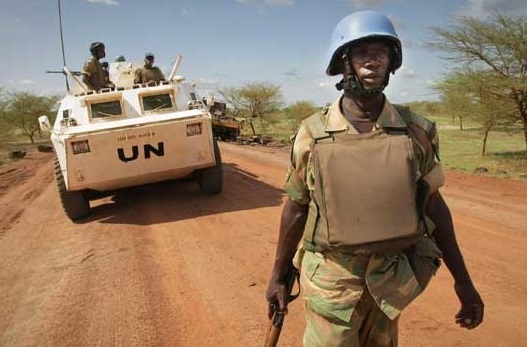
On October 30, 2016, the French Minister of Defense, Jean-Yves Le Drian was in Bangui, Central African Republic to end the French military help to the UN peacekeeping troops. He claimed that the French mission had been “a success.”
On December 5, 2013, the UN Security Council unanimously authorized France to send additional troops to the Central African Republic to reinforce an African Union peacekeeping force and some 600 French troops already there. The goal was to stop violence in the capital Bangui. It must be noted that the Security Council resolution was largely drafted by French diplomats at the UN who had worked steadily the days before for its adoption. However, many countries were pleased that the French took the initiative as they were planning to do nothing. France had troops and air force logistics in nearby Gabon and Cameroon. Less than 24 hours after adopting the resolution, there were French troops on the ground in Bangui.
There then emerged the immediate problem of violence among tribal-based militias in the absence of a national army or central government security forces. The militias basically pitted the north of the country against the south. Since the geographic division also covers a Muslim north and a Christian south, the conflict had taken on a religious color, but was not theological. In addition, there are other militias from the Democratic Republic of Congo which use the Central African Republic as a “safe haven” and live off the land by looting villages. There are also segments of Lord’s Resistance Army, largely from the Acholi tribes of northern Uganda who use the Central African Republic as a safe area, looting as they move about.
It is unlikely that Defense Ministers ever publicly call a mission “a failure,” but the operation in the Central African Republic does raise a number of broader questions. How effective are peacekeeping operations in preventing and stopping violence? Are there alternatives to the ways that the United Nations and regional organizations such as the African Union currently carry out peacekeeping operations? How effective are peacekeeping operations in addressing the root causes of the conflict? How does one measure the effectiveness of peacekeeping operations?
At the same time as the French Minister of Defense was expressing his satisfaction, UN Deputy Secretary-General Jan Eliasson was in Bangui speaking to the members of the Parliament on the “daunting challenges” facing the country: one million displaced, half the population needing humanitarian assistance, and virtually all infrastructure and essential services needing to be rebuilt. (Built would have been the more accurate verb.) He called upon the members of the Parliament to be defenders of dialogue and reconciliation, explaining that “reconciliation should be at the heart of your efforts. To guide the country on the path of peace, reconciliation and development, it is essential to work together.”
The area covered by the current Central African Republic had no pre-colonial common history. It was incorporated into French Equatorial Africa but could have as easily been part of the Belgium Congo or added to Uganda as part of British East Africa. Oubangui-Chari, as it was known then, was the poor cousin of French Equatorial Africa whose administrative center was Brazzaville, Congo.
Since 1979 when Jean-Bedel Bokasa who ruled (or misruled) as the Emperor Bokasa was replaced by a French military intervention after Bokasa had too visibly killed young school children who were protesting, all pretext of a unified administration has disappeared. General Kolingba, Ange-Felix Patassé, followed by Francois Bozize were considered “Heads of State” but the state had no administration. Bozize was overthrown in March 2013 by Michel Djotodia. Djotodia was the first Muslim to be Head of State. A floating population of jihadists came from outside the country and joined Muslim militias. In reaction, Christian self-defense militias were created.
Now under French pressure, there have been elections. The new president is Faustin Touadera. The UN provides a Multidimensional Integrated Stabilization of nearly 10,000 people. Troops, international or national, can sometimes restore “calm,” but they rarely deal with the fundamental cause of tensions. Other agents are needed to develop the economic and social capacity of the state and to build bridges among communities. What is required today in the Central African Republic are reconciliation bridge-builders, people who are able to restore relations among the ethnic groups of an area. The UN national governments, and non-governmental organizations need to develop bridge-building teams which can help to strengthen local efforts at conflict resolution and re-establish community relations.
World citizens were among those in the early 1950s who stressed the need to create UN peace-keeping forces with soldiers trained for such international tasks. Later, we proposed a standing “ready reserve” of UN forces as the time lag between a crisis and the fielding of national units under UN command can be relatively long, usually several months. There are no permanent UN-trained and motivated troops. There are only national troops loaned by some national governments but paid for by all the UN member states. Each government trains its army in its own spirit and values, though there is still an original English ethos as many UN troops come from India, Pakistan, Bangladesh, Nepal, and Nigeria. The current UN peacekeeping troops are not trained for loyalty to the UN and its values.
Today, a new type of world civil servant is needed – those who in areas of tension and conflict can undertake the slow but important task of restoring confidence among peoples in conflict, establishing contacts and looking for ways to build upon common interests.
Rene Wadlow, President, Association of World Citizens.
